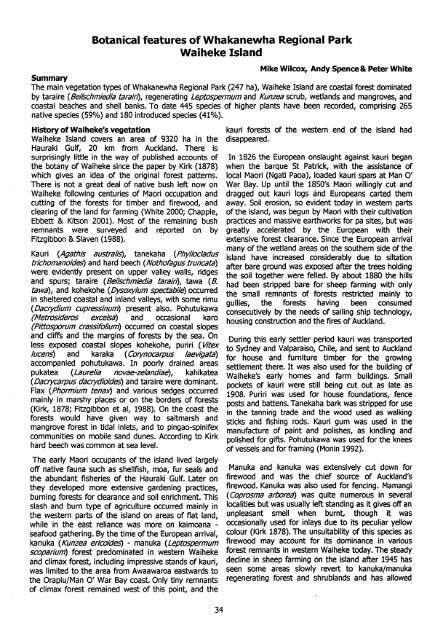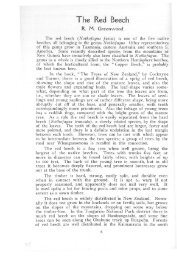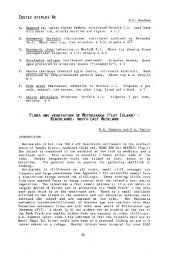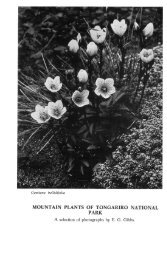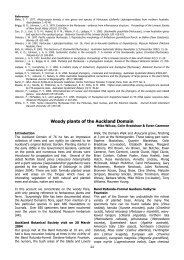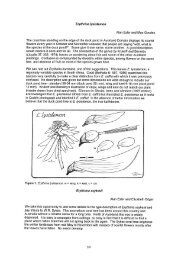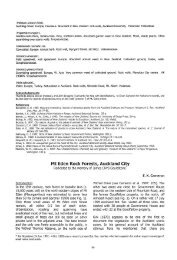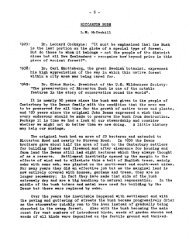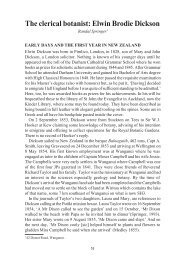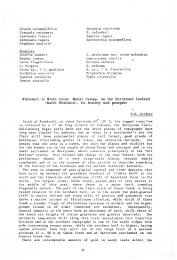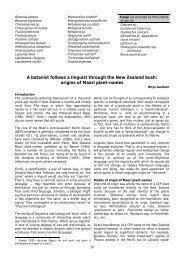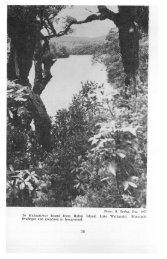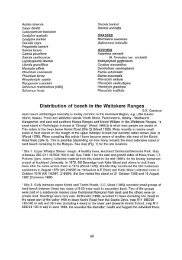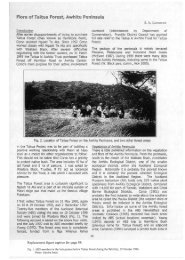Botanical features of Whakanewha Regional Park Waiheke Island
Botanical features of Whakanewha Regional Park Waiheke Island
Botanical features of Whakanewha Regional Park Waiheke Island
Create successful ePaper yourself
Turn your PDF publications into a flip-book with our unique Google optimized e-Paper software.
<strong>Botanical</strong> <strong>features</strong> <strong>of</strong> <strong>Whakanewha</strong> <strong>Regional</strong> <strong>Park</strong><br />
<strong>Waiheke</strong> <strong>Island</strong><br />
Mike Wilcox Andy Spence & Peter White<br />
Summary<br />
The main vegetation types <strong>of</strong> <strong>Whakanewha</strong> <strong>Regional</strong> <strong>Park</strong> (247 ha) <strong>Waiheke</strong> <strong>Island</strong> are coastal forest dominated<br />
by taraire {Beilschmiedia tarairi) regenerating Leptospermum B\\6 Kunzea scrub wetlands and mangroves a<br />
coastal beaches and shell banks. To date 445 species <strong>of</strong> higher plants have been recorded comprising 265<br />
native species (59%) and 180 introduced species (41%).<br />
History <strong>of</strong> <strong>Waiheke</strong>s vegetation<br />
kauri forests <strong>of</strong> the western end <strong>of</strong> the island had<br />
<strong>Waiheke</strong> <strong>Island</strong> covers an area <strong>of</strong> 9320 ha in the disappeared.<br />
Hauraki Gulf 20 km from Auckland. There is<br />
surprisingly little in the way <strong>of</strong> published accounts <strong>of</strong><br />
the botany <strong>of</strong> <strong>Waiheke</strong> since the paper by Kirk (1878)<br />
which gives an idea <strong>of</strong> the original forest patterns.<br />
There is not a great deal <strong>of</strong> native bush left now on<br />
<strong>Waiheke</strong> following centuries <strong>of</strong> Maori occupation and<br />
cutting <strong>of</strong> the forests for timber and firewood and<br />
clearing <strong>of</strong> the land for farming (White 2000; Chappie<br />
In 1826 the European onslaught against kauri began<br />
when the barque St Patrick with the assistance <strong>of</strong><br />
local Maori (Ngati Paoa) loaded kauri spars at Man O<br />
War Bay. Up until the 1850s Maori willingly cut and<br />
dragged out kauri logs and Europeans carted them<br />
away. Soil erosion so evident today in western parts<br />
<strong>of</strong> the island was begun by Maori with their cultivation<br />
Ebbett & Kitson 2001). Most <strong>of</strong> the remaining bush practices and massive earthworks for pa sites but was<br />
remnants were surveyed and reported on by greatly accelerated by the European with their<br />
Fitzgibbon & Slaven (1988).<br />
extensive forest clearance. Since the European arrival<br />
many <strong>of</strong> the wetland areas on the southern side <strong>of</strong> the<br />
Kauri {Agathis australis) tanekaha {Phyllocladus island have increased considerably due to siltation<br />
trichomanoides) and hard beech {Noth<strong>of</strong>agus truncata) after bare ground was exposed after the trees holding<br />
were evidently present on upper valley walls ridges the soil together were felled. By about 1880 the hills<br />
and spurs; taraire {Beilschmiedia tarairi) tawa {B. had been stripped bare for sheep farming with only<br />
tawa) and kohekohe {Dysoxylum spectabile occurred the small remnants <strong>of</strong> forests restricted mainly to<br />
in sheltered coastal and inland valleys with some rimu gullies the forests having been consumed<br />
{Dacrydium cupressinum) present also. Pohutukawa consecutively by the needs <strong>of</strong> sailing ship technology<br />
(Metrosideros excelsa) and occasional karo housing construction and the fires <strong>of</strong> Auckland.<br />
(Pittosporum crassifolium) occurred on coastal slopes<br />
and cliffs and the margins <strong>of</strong> forests by the sea. On<br />
less exposed coastal slopes kohekohe puriri {Vitex<br />
During this early settler period kauri was transported<br />
to Sydney and Valparaiso Chile and sent to Auckland<br />
lucens) and karaka {Corynocarpus laevigata)<br />
for house and furniture timber for the growing<br />
accompanied pohutukawa. In poorly drained areas<br />
settlement there. It was also used for the building <strong>of</strong><br />
pukatea {Laurelia novae zelandiae) kahikatea<br />
<strong>Waiheke</strong>s early homes and farm buildings. Small<br />
{Dacrycarpus dacrydioides) and taraire were dominant.<br />
Flax {Phormium tenax and various sedges occurred<br />
mainly in marshy places or on the borders <strong>of</strong> forests<br />
(Kirk 1878; Fitzgibbon et al 1988). On the coast the<br />
forests would have given way to saltmarsh and<br />
mangrove forest in tidal inlets and to pingao spinifex<br />
communities on mobile sand dunes. According to Kirk<br />
hard beech was common at sea level.<br />
The early Maori occupants <strong>of</strong> the island lived largely<br />
<strong>of</strong>f native fauna such as shellfish moa fur seals and<br />
the abundant fisheries <strong>of</strong> the Hauraki Gulf. Later on<br />
they developed more extensive gardening practices<br />
burning forests for clearance and soil enrichment. This<br />
slash and burn type <strong>of</strong> agriculture occurred mainly in<br />
the western parts <strong>of</strong> the island on areas <strong>of</strong> flat land<br />
while in the east reliance was more on kaimoana<br />
seafood gathering. By the time <strong>of</strong> the European arrival<br />
kanuka {Kunzea ericoides) manuka {Leptospermum<br />
scoparium) forest predominated in western <strong>Waiheke</strong><br />
and climax forest including impressive stands <strong>of</strong> kauri<br />
was limited to the area from Awaawaroa eastwards to<br />
the Orapiu/Man O War Bay coast. Only tiny remnants<br />
<strong>of</strong> climax forest remained west <strong>of</strong> this point and the<br />
34<br />
pockets <strong>of</strong> kauri were still being cut out as late as<br />
1908. Puriri was used for house foundations fence<br />
posts and battens. Tanekaha bark was stripped for use<br />
in the tanning trade and the wood used as walking<br />
sticks and fishing rods. Kauri gum was used in the<br />
manufacture <strong>of</strong> paint and polishes as kindling and<br />
polished for gifts. Pohutukawa was used for the knees<br />
<strong>of</strong> vessels and for framing (Monin 1992).<br />
Manuka and kanuka was extensively cut down for<br />
firewood and was the chief source <strong>of</strong> Aucklands<br />
firewood. Kanuka was also used for fencing. Mamangi<br />
{Coprosma arborea) was quite numerous in several<br />
localities but was usually left standing as it gives <strong>of</strong>f an<br />
unpleasant smell when burnt though it was<br />
occasionally used for inlays due to its peculiar yellow<br />
colour (Kirk 1878). The unsuitability <strong>of</strong> this species as<br />
firewood may account for its dominance in various<br />
forest remnants in western <strong>Waiheke</strong> today. The steady<br />
decline in sheep farming on the island after 1945 has<br />
seen some areas slowly revert to kanuka/manuka<br />
regenerating forest and shrublands and has allowed
forest remnants to revive. Much <strong>of</strong> the regenerating<br />
forest has sprung up since then.<br />
<strong>Whakanewha</strong> <strong>Regional</strong> <strong>Park</strong><br />
<strong>Whakanewha</strong> <strong>Regional</strong> <strong>Park</strong> is contained within the<br />
Inner Gulf <strong>Island</strong>s Ecological District which lies within<br />
the Auckland Ecological Region. It was purchased for<br />
recreation and conservation development in 1993 and<br />
added to the estate <strong>of</strong> some 22 parks administered by<br />
the Auckland <strong>Regional</strong> Council. Located on the western<br />
side <strong>of</strong> the island next to Rocky Bay and accessed via<br />
Gordons Road the park covers some 247 hectares<br />
(Figure l).The history <strong>of</strong> the area is well documented<br />
(Anon. 1996) and as has aptly been put by Monin<br />
(1992) "... at <strong>Whakanewha</strong> the spirit <strong>of</strong> countless<br />
Maori generations pervades the calm <strong>of</strong> an<br />
undisturbed tidal beach ".<br />
The main vegetation types are coastal forest<br />
regenerating scrub wetlands and coastal beaches and<br />
shell banks. Clunie (1992a 1992b 1992c) Cutting &<br />
Green (1992) and Gardner (1995) have previously<br />
reported on the vegetation and flora. Other<br />
publications on the <strong>Waiheke</strong> flora relevant to<br />
<strong>Whakanewha</strong> are the account <strong>of</strong> mosses by Jessica<br />
Beever (1995) and Mike Lees (1999) paper on some<br />
islets <strong>of</strong>f <strong>Waiheke</strong>.<br />
The Auckland <strong>Botanical</strong> Society held an excursion to<br />
the park on 17 November 2001 and were joined by<br />
several <strong>Waiheke</strong> residents.<br />
Locals: Andy Spence Don Chappie Rainelia Wylde<br />
Graham Hooper Jaymz Hooper.<br />
Bot Soci Mike Wilcox Maureen Young Lisa<br />
Clapperton Brian Cumber Doug Shaw Fawzi Karem<br />
Morag McDonald Pam Carmont Pat<br />
Harry<br />
Beecham Carol McSweeney Steve Cook Shelley<br />
Heiss Dunlop Alistair McArthur Fran Hinz Alison<br />
Wesley Juliet Richmond Shirley Smith Annette<br />
Lindsay Sandra Jones Leslie Haines Sarah Flynn<br />
Allan Flynn Robin Gee.<br />
Our route was along the Tarata Track to the Cascades<br />
and then down to the beach via the Nikau Track<br />
followed by exploration <strong>of</strong> the coastal wetlands.<br />
Further visits were made by the authors in December<br />
2001 January 2002 (2) February 2002 and April<br />
2002.<br />
Coastal forest and scrub<br />
The dominant canopy trees in the remnant native bush<br />
at <strong>Whakanewha</strong> are taraire and tawa frequently<br />
accompanied by rewarewa<br />
{Knightia excelsa) kohekohe<br />
puriri and karaka. Typically the<br />
canopy height is c. 16 rn. There<br />
are also occasional northern rata<br />
{Metrosideros robusta) pohutukawa<br />
{M. excelsa) mangeao<br />
{Litsea calicaris) matai {Prumnopitys<br />
taxifolia) rimu common<br />
kowhai {Sophora microphylla) and<br />
coastal kowhai {S. chathamica).<br />
On the slopes downhill from<br />
Rocky Bay is a line <strong>of</strong> seven large<br />
puriri trees known as The<br />
Cathedral" said to have been<br />
planted by Maori residents in<br />
ancient times. One giant karaka<br />
tree is 22 rn tall and 90 cm<br />
diameter. Kauri is scarce but the<br />
few biggish trees recorded (we<br />
have counted only four) appear to<br />
be very vigorous.<br />
Figure 1: Map <strong>of</strong> <strong>Whakanewha</strong> <strong>Regional</strong> <strong>Park</strong> <strong>Waiheke</strong> <strong>Island</strong><br />
The subcanopy and understorey<br />
includes mamangi Wharangi<br />
{Melicope ternata) mahoe<br />
{Melicytus ramiflorus) hangehange<br />
{Geniostoma rupestre var.<br />
ligustrifolium) mapou {Myrsine<br />
australis) tarata {Pittosporum<br />
eugenioides) nikau {Rhopalostylis<br />
sapida) kawakawa {Macropiper<br />
excelsum) and lancewood<br />
{Pseudopanax crassifolium). The<br />
dominant tree ferns are silver fern<br />
{Cyathea dealbata) and mamaku<br />
35
Fig.2: Coastal forest dominated by taraire {Beilschmiedia tarairi<br />
(C. medullaris) whilst wheki {Dicksonia squarrosa)<br />
occurs much more locally on moister sites. Coprosma<br />
rhamnoides is a common twiggy shrub. Uncommon<br />
small trees are kaikomako {Pennantia corym-bosa) and<br />
milk tree {Streblus heterophyllus). The shrubby<br />
epiphyte Pittosporum cornifolium is sometimes seen<br />
perching high up in puriri trees.<br />
An interesting mixed pole<br />
hardwood forest occupies about<br />
one hectare in the upper part <strong>of</strong><br />
the park. It is evidently a<br />
successional stage after<br />
manuka and now comprises c.<br />
10 20 OOO stems/ha <strong>of</strong> mainly<br />
mamangi and mapou 4 10 cm<br />
in diameter and with a canopy<br />
height <strong>of</strong> c. 8 m. Seedlings and<br />
saplings <strong>of</strong> kohekohe and other<br />
tree species are sprinkled<br />
through the stand indicating<br />
the likely composition <strong>of</strong> the<br />
eventual high forest.<br />
There are abundant<br />
interspersed seral stands <strong>of</strong><br />
kanuka and manuka the<br />
kanuka commonly being 8 9 m<br />
in height with regenerating<br />
mahoe rangiora {Brachyglottis<br />
repanda) mapou kawakawa<br />
mamangi and abundant silver<br />
tree fern beneath. These stands<br />
are generally festooned<br />
beneath with climbing asparagus<br />
{Asparagus scandens).<br />
On shaded damp banks around<br />
the Cascades stream and<br />
waterfall or as epiphytes<br />
conditions are suitable for filmy<br />
ferns and Trichomanes<br />
elongatum T. endlicherianum<br />
T. venosum Hymenophyllum<br />
flexuosum H. sanguinolentum<br />
H. demissum and H.<br />
flabellatum were recorded.<br />
Hymenophyllum rarum has<br />
been found in the swamp forest<br />
area <strong>of</strong> the lower Cascades<br />
stream.<br />
Outstanding <strong>features</strong> seen<br />
during the excursion were fine<br />
examples <strong>of</strong> five finger<br />
{Pseudopanax arboreus)<br />
epiphytic on silver tree ferns<br />
several exceptionally large<br />
trees <strong>of</strong> lancewood {Pseudopanax<br />
crassifolius) natural<br />
nursery patches <strong>of</strong> dense<br />
regenerating seedlings <strong>of</strong><br />
Wharangi examples <strong>of</strong> the<br />
rare fern Lastreopsis velutina<br />
a population <strong>of</strong> kiekie {Freycinetia baueriana subsp.<br />
banksii) which is generally uncommon on <strong>Waiheke</strong><br />
and regenerating kaikomako {Pennantia corymbosa).<br />
The ground flora in the coastal forest is <strong>of</strong>ten quite<br />
sparse but beside the tracks could be found some fine<br />
flowering patches <strong>of</strong> hooded orchid {Pterostylis<br />
Fig.3: Open kanuka {Kunzea ericoides) forest with understorey <strong>of</strong><br />
silver fern {Cyathea dealbata)<br />
36
anksii) Acianthus sinclairii frequent Gahnia lacera<br />
Oplismenus hirtellus subsp imbecilus Uncinia<br />
uncinata Carex breviculmis Carex spinirostris<br />
Diane/Ia nigra (in flower) Veronica plebeia<br />
Hydrocotyle dissecta Ranunculus reflexus Lobelia<br />
anceps Hypericum humifusum H. japonicum<br />
Dichondra repens Centella uniflora Euchiton<br />
gymnocephalus and numerous ferns including<br />
Asplenium lamprophyllum A. gracillimum Pteris<br />
saxatilis P. macilenta and Doodia australis. The<br />
Australian sedge {Carex longebrachiata) is frequent<br />
beside the bush tracks. It has persisted from the time<br />
it was a prominent pasture weed when the land was<br />
farmed. Nikau seedlings are abundant throughout.<br />
Damp places within scrub or forest support a community<br />
<strong>of</strong> prostrate plants commonly Callitriche muelleri<br />
Ranunculus amphitrlchus Juncus articulatus Isolepis<br />
reticularis and Schoenus maschalinus True "gumland"<br />
conditions are not present in <strong>Whakanewha</strong> but certain<br />
areas <strong>of</strong> shallower more impoverished clay soils have<br />
some typical gumland species such as Lepidosperma<br />
australe Baumea tenax Lindsaea linearis and<br />
Gonocarpus incanus<br />
The pa site above the beach is noteworthy for large<br />
old trees <strong>of</strong> puriri ngaio {Myoporum laetum)<br />
kohekohe tawa taraire matai kowhai an impressive<br />
hinau {Elaeocarpus dentatus) and populations <strong>of</strong><br />
native passion vine {Passiflora tetrandra). A prominent<br />
weed there is herb Robert {Geranium robertianum).<br />
Moth plant {Araujia serie/fera) still persists despite<br />
strenuous efforts by the local park workers to<br />
eliminate it.<br />
Shell banks and beach<br />
The sandy beach at <strong>Whakanewha</strong> is backed by shell<br />
banks which have been colonised to various degrees<br />
by plants. On the sand itself there are a few patches <strong>of</strong><br />
spinifex {Spinifex sericeus) and some planted pingao<br />
{Desmoschoenus spiraiis).There is also a fine clump <strong>of</strong><br />
planted Cortaderia splendens at the main picnic area<br />
The freshest shell banks have only a sparse<br />
vegetation with plants such as native ice plant<br />
{Disphyma australe) beach celery {Apium<br />
prostratum) sea rocket {Cakile edentula) knob sedge<br />
{Isolepis nodosa) salt marsh tussock {Austrostipa<br />
stipoides) shore bind weed {Calystegia soldanella)<br />
beach orache {Atriplex prostrata) Haloragis erecta<br />
and Senecio lautus. Muehlenbeckia complexa is an<br />
abundant scrambler in coastal sites throughout<br />
<strong>Whakanewha</strong>. Damper areas have abundant bachelors<br />
button {Cotula coronopifolia) glasswort {Sarcocornia<br />
quinqueflora) Selliera radicans Samolus repens and<br />
Isolepis cernua.<br />
The older more stable shell banks and beach have<br />
become colonised by numerous plants mostly<br />
introduced prominent among which are buffalo grass<br />
{Stenotaphrum secundatum) Gladiolus undulatus wild<br />
onion {Allium vineale) rough clover (Trifolium<br />
scabrum) lesser suckling clover {T. micranthum)<br />
smooth tare (Vicia tetrasperma) hairy birdsfoot trefoil<br />
{Lotus suaveolens) hawkbit {Leontodon taraxacoides)<br />
Avena barbata Poa pratensis Lagurus ovatus Bromus<br />
diandrus Briza maxima Anagallis arvensis Anagallis<br />
arvensis var. coerulea Arctotheca calendula Beta<br />
vulgaris Cichorium intybus Geranium molle Geranium<br />
purpureum Linum bienne Medicago nigra Melilotus<br />
Fig.4: Shellbank and lagoon behind the beach with clumps <strong>of</strong> glasswort {Sarcocornia<br />
quinqueflora) and tussocks <strong>of</strong> coastal needle grass {Austrostipa stipoides)<br />
37
indicus Osteospermum barberiae Polycarpon Within the forest are some sedge swamps the<br />
tetraphyllum Ranunculus scleratus Senecio dominant species being Carex lessoniana C geminata<br />
bipinnatisectus Senecio lautus Silene gallica Sonchus Carex virgata and Baumea tenax.<br />
asper Trifolium repens and Verbascum creticum.<br />
Damp open sites have native rushes Juncus<br />
There is a small bush clad rocky island in the<br />
sarophorus J. australis and 1 edgariae. Wind grass<br />
Poukaraka wetland on which is growing a thriving<br />
{Lachnagrostis filiformis) is common in places on<br />
population <strong>of</strong> the locally rare shrub Pomaderris rugosa.<br />
stabilised shell banks while sand wind grass (L<br />
Elsewhere on <strong>Waiheke</strong> this species is known from the<br />
billardieri) can be found occasionally on the sandy eastern coastal margin <strong>of</strong> Te Matuku Bay and it has<br />
beach.<br />
recently been discovered on Rotoroa <strong>Island</strong> and a<br />
small unnamed islet between Rotoroa and Ponui<br />
Wetlands<br />
<strong>Island</strong>s. On the island at <strong>Whakanewha</strong> some 23 plants<br />
Sheltered coastal estuaries are fringed by mangroves were recorded on 31 December 2001 all healthy and<br />
{Avicennia marina var. australasica) and associated salt vigorous. The island also has numerous small trees <strong>of</strong><br />
marshes with shore ribbonwood {Plagianthus Wharangi and coastal kowhai and a good deal <strong>of</strong><br />
divaricatum shore rush {Juncus kraussi/ var. gorse though it is seemingly not posing a threat to the<br />
australiensis) Juncus pallidus) Baumea juncea Samolus Pomaderris rugosa.<br />
repens Selliera radicans Lilaeopsis novaezelandiae and<br />
Apium prostratum subsp prostratum var. filiforme<br />
Two swamp species Hydrocotyle pterocarpa and<br />
Triglochin striata Parapholis strigosa and Polypogon<br />
Ranunculus urvilleanus recorded by Gardner (1995) are<br />
monspeliensis. The introduced Carex divisa as<br />
considered to be uncommon in the Tamaki Ecological<br />
elsewhere in Auckland has heavily invaded the margins<br />
District<br />
<strong>of</strong> the salt marshes. Growing also on the fringe is Coastal cliffs<br />
clustered dock {Rumex conglomeratus) with reddish Pohutukawa trees cling to the greywacke cliffs which<br />
fruiting heads and the more robust curled dock (/?.. also support colonies <strong>of</strong> Poa anceps and extensive<br />
crispus). Swamp bindweed {Calystegia sepium) abounds patches <strong>of</strong> Peperomia urvilleana which is also locally<br />
in wet areas. Where streams open out into the narrow plentiful at the base <strong>of</strong> trees above the Cascades<br />
lagoons behind the shell banks are beds <strong>of</strong> Stream. Boneseed {Chrysanthemoides monolifer) is a<br />
Bolboschoenus medianus together with Apodasmia cliff face colonist together with Rytidosperma<br />
similis and with Cyperus ustulatus prominent on drier penicillatum Aira caryophyllea Dichelachne crinita<br />
land at the back. Sea aster {Aster subulatus) is abundant Senecio hispidulus and Verbascum creticum.<br />
in places.<br />
Further upstream from the coast in the extensive 6<br />
Rarity <strong>of</strong> certain native species at <strong>Whakanewha</strong><br />
hectare Poukaraka Wetland also known as the Rocky<br />
A noteworthy feature <strong>of</strong> the <strong>Whakanewha</strong> flora is that<br />
Bay Wetland with increasingly freshwater conditions are<br />
a number <strong>of</strong> native species there which otherwise are<br />
prominent beds <strong>of</strong> raupo {Typha orientalis) adjoining<br />
fairly common around Auckland were encountered by<br />
extensive stands <strong>of</strong> freshwater club rush {Bolboschoenus<br />
us in just single colonies or occurrences and this was<br />
fluviatilis) and flax {Phormium tenax). There is swamp<br />
after comprehensive traverses over the whole park.<br />
millet (Isachne globosa) bulrush {Schoenoplectus<br />
These locally rare species include Blechnum fraseri<br />
tabemaemontani) Eleocharis acuta Isolepis prolifera<br />
Epilobium rotundifolium Gleichenia microphylla<br />
Apodasmia similis Baumea juncea B. rubiginosa Juncus<br />
Hymenophyllum rarum Hypolepis distans (not known<br />
effusus Carex virgata C secta C solandri where the<br />
elsewhere on <strong>Waiheke</strong> <strong>Island</strong>) and Laurelia novaezelandiae.<br />
forest joins the wetlands and occasionally C maorica<br />
and patches <strong>of</strong> Paspalum vaginatum where the water is<br />
brackish. Herbaceous dicot water plants in the<br />
freshwater upper reaches <strong>of</strong> the wetland include<br />
Polygonum salicifolium Ludwigia palustris Rorippa<br />
nasturtium aquaticum Myosotis laxa and Callitriche<br />
stagnalis. About a dozen clumps <strong>of</strong> toetoe {Cortaderia<br />
fulvida) occur scattered about in a sea <strong>of</strong> freshwater<br />
club rush. We were unable to reach these plants and the<br />
possibility remains that it is C splendens.<br />
On the floodplain <strong>of</strong> the Cascade Stream as it nears its<br />
outlet into the Poukaraka Wetland the ferns Diplazium<br />
australe and Depariapetersenii arecommonly found. In<br />
this area a lone pukatea {Laurelia novae zelandiae)<br />
stands tall above thickets <strong>of</strong> grey willow {Salix cinerea)<br />
and tobacco weed {Solanum mauritianum).<br />
Weeds<br />
It has to be said that weeds are something <strong>of</strong> a<br />
feature at <strong>Whakanewha</strong>. The worst <strong>of</strong> them is climbing<br />
asparagus which is all too common in the kanuka<br />
stands and open bush areas and has a strong grip.<br />
Carex divisa is common through the salt marsh<br />
fringes; Carex longebrachiata occurs abundantly<br />
throughout the park all along the track margins;<br />
tobacco weed {Solanum mauritianum) honeysuckle<br />
{Lonicera japonica) and moth plant {Araujia serie/fera)<br />
rapidly invade disturbed bush sites; and infestations <strong>of</strong><br />
Smilax {Asparagus asparagoides) are particularly bad in<br />
the shell bank area where gorse and buffalo grass also<br />
abound.<br />
38
<strong>Waiheke</strong> native species not recorded at<br />
<strong>Whakanewha</strong><br />
Several native plants occurring elsewhere on <strong>Waiheke</strong><br />
<strong>Island</strong> but not yet recorded in <strong>Whakanewha</strong> are:<br />
Aristotelia serrata Arthropteris tenella Blechnum<br />
discolor Calystegia tuguriorum Cardiomanes<br />
reniforme Coprosma propinqua Cordyline pumilio<br />
Coriaria arborea Cyathea smithii Drymoanthus<br />
adversus Earina autumnalis Grammitis billardierei<br />
Hebe macrocarpa Hymenophyllum dilatatum Lindsaea<br />
trichomanoides Nestegis montana Noth<strong>of</strong>agus<br />
truncata Pseudognaphalium luteoalbum Pteris<br />
comans Schizaea dichotoma Streblus banksii<br />
Syzygium maire and Weinmannia silvicola.<br />
Senecio lautus on shellbank Whakanewa <strong>Regional</strong> <strong>Park</strong><br />
<strong>Waiheke</strong> <strong>Island</strong> 13 Oct 2001.<br />
Disphyma australe subsp australe on shellbank Whakanewa <strong>Regional</strong> <strong>Park</strong><br />
<strong>Waiheke</strong> <strong>Island</strong> 13 Oct 2001.<br />
39
Species list<br />
Legend: adventive pl. planted.<br />
Maori name Common name<br />
Scientific name<br />
Ferns<br />
Adiantum cunninghamii<br />
Adiantum diaphanum<br />
Adiantum fulvum<br />
Adiantum hispidulum<br />
Adiantum raddianum<br />
Adiantum viridescens<br />
Anarthropteris lanceolata<br />
Asplenium bulbiferum subsp.<br />
bulbiferum<br />
Asplenium bulbiferum<br />
gracillimum<br />
subsp.<br />
Asplenium flaccidum subsp.<br />
flaccidum<br />
Asplenium<br />
Asplenium<br />
lamprophyllum<br />
oblongi folium<br />
Asplenium polyodon<br />
blechnum chambersii<br />
[Blechnum filiforme<br />
[Blechnum fluviatile<br />
Blechnum fraseri<br />
Blechnum membranaceum<br />
[Blechnum novae zelandiae<br />
(incl. B. minus)<br />
[Cyathea dealbata<br />
Cyathea<br />
Deparia<br />
Dicksonia<br />
medullaris<br />
petersenii<br />
squarrosa<br />
Diplazium australe<br />
Doodia australis<br />
Gleichenia microphylla<br />
Histiopteris incisa<br />
Hymenophyllum demissum<br />
Hymenophyllum flabellatum<br />
Hymenophyllum flexuosum<br />
Hymenophyllum rarum<br />
Hymenophyllum<br />
sanguinolentum<br />
Hypolepis distans<br />
Lastreopsis glabella<br />
Lastreopsis hispida<br />
Lastreopsis microsora<br />
Lastreopsis velutina<br />
Lindsaea linearis<br />
Lygodium articulatum<br />
Marattia salicina<br />
Microsorum<br />
Microsorum<br />
Paesia<br />
scaberula<br />
Pneumatopteris<br />
Polystichum<br />
Pteridium<br />
Pteris<br />
macilenta<br />
pustu/atum<br />
scandens<br />
richardii<br />
esculentum<br />
pennigera<br />
Pteris saxatilis<br />
Pteris tremula<br />
Pyrrosia eleagnifolia<br />
Trichomanes elongatum<br />
Trichomanes<br />
endlicherianum<br />
Puhinui<br />
whare ngarara<br />
mouku mouki<br />
mauku<br />
manamana<br />
mouku<br />
makawe o<br />
raukatauri<br />
raukatauri<br />
huruhuruwhenua<br />
parenako<br />
paretao<br />
petako<br />
rereti nini<br />
panako<br />
kiwakiwa<br />
maukurangi<br />
kiokio & swamp<br />
kiokio<br />
ponga<br />
mamaku korau<br />
jpitau<br />
Wheki tirawa<br />
Pukupuku<br />
piripiri<br />
tuakura<br />
mangemange<br />
para<br />
kowaowao<br />
Paraharaha<br />
mokimoki<br />
matata<br />
pakauroharoha<br />
piupiu<br />
Pikopiko<br />
rahurahu rarauhe<br />
rarahu<br />
titipo<br />
turawera<br />
ngarara wehi<br />
(= Crepidomanes<br />
endlicherianum)<br />
common maidenhair ]<br />
small maidenhair<br />
hairy maidenhair<br />
rosy maidenhair<br />
a maidenhair fern<br />
lance fern<br />
hen and chickens<br />
fern<br />
hen and chickens<br />
fern<br />
hanging spleenwort j<br />
drooping<br />
spleenwort<br />
shining spleenwort<br />
sickle spleenwort<br />
lance fern<br />
thread fern<br />
creek fern<br />
miniature tree fern.<br />
silver tree fern<br />
black tree fern<br />
rough or harsh tree<br />
fern<br />
rasp fern<br />
umbrella fern<br />
filmy fern<br />
filmy fern<br />
filmy fern<br />
filmy fern<br />
filmy fern<br />
smooth shield fern<br />
hairy fern<br />
velvet fern<br />
bushmans mattress<br />
king fern (pl.)<br />
hounds tongue<br />
fragrant fern<br />
hard scented lace or<br />
ring fern<br />
gully fern feather<br />
fern<br />
common shield fern<br />
bracken Austral<br />
bracken<br />
sweet brake sweet<br />
fern<br />
a brake fern<br />
shaking brake<br />
leather leaf fern<br />
bristle fern<br />
bristle fern<br />
Fern allies<br />
Lycopodium deuterodensum<br />
Lycopodium varium (=<br />
Huperzia varia)<br />
Selaginella kraussiana<br />
Tmesipteris elongata<br />
Tmesipteris lanceolata<br />
Tmesipteris tannensis<br />
Conifers<br />
Agathis australis<br />
Dacrycarpus dacrydioides<br />
Dacrydium cupressinum<br />
Libocedrus plumosa<br />
Phyllocladus trichomanoides<br />
Podocarpus totara<br />
Prumnopitys ferruginea<br />
Prumnopitys taxifolia<br />
Dicot trees and shrubs<br />
Alectryon excelsus<br />
Alseuosmia macrophylla<br />
Alseuosmia quercifolia<br />
Avicennia marina var.<br />
australasica<br />
Beilschmiedia tarairi<br />
Beilschmiedia tawa<br />
Brachyglottis repanda<br />
Carmichaelia australis<br />
Carpodetus serratus<br />
Coprosma arborea<br />
Coprosma areolata<br />
Coprosma grandifolia<br />
Coprosma lucida<br />
Coprosma macrocarpa<br />
Coprosma propinqua x robusta<br />
or macrocarpa<br />
Coprosma rhamnoides<br />
Coprosma robusta<br />
Coprosma robusta x<br />
C. rhamnoides<br />
Coprosma spathulata<br />
Corynocarpus laevigatus<br />
Cotoneaster glaucophyllus<br />
Dodonaea viscosa<br />
Dysoxylum spectabile<br />
Elaeagnus x reflexa<br />
Elaeocarpus dentatus<br />
Entelea arborescens<br />
Eriobotrya japonica<br />
Eucalyptus botryoides<br />
Eucalyptus saligna<br />
Fuchsia excorticata<br />
[Geniostoma rupestre var.<br />
ligustrifolium<br />
[Griselinia lucida<br />
•Hebe stricta<br />
[Hedycarya arborea<br />
[Hoheria populnea<br />
[Knightia excelsa<br />
Kunzea ericoides<br />
Laurelia novae zelandiae<br />
Leptospermum scoparium<br />
Leucopogon fasciculatus<br />
Leucopogon fraseri<br />
Leycesteria formosa<br />
[Ligustrum lucidum<br />
Ligustrum sinense<br />
[Litsea calicaris<br />
Lophostemon confertus<br />
Lycium ferocissimum<br />
puakarimu<br />
iwituna<br />
kauri<br />
kahikatea<br />
rimu<br />
kawaka<br />
tanekaha<br />
totara<br />
miro<br />
matai<br />
titoki<br />
toropapa<br />
manawa<br />
taraire<br />
tawa<br />
rangiora<br />
maukoro<br />
putaputaweta<br />
mamangi<br />
kanono<br />
karamu<br />
karamu<br />
karaka<br />
akeake<br />
kohekohe<br />
hinau<br />
whau<br />
kotukutuku<br />
hangehange<br />
puka<br />
koromiko<br />
porokaiwhiri<br />
houhere<br />
rewarewa<br />
kanuka<br />
pukatea<br />
manuka<br />
mingimingi<br />
patotara<br />
mangeao<br />
club moss<br />
hanging clubmoss<br />
tassel fern<br />
African club moss<br />
Selaginella<br />
a fork fern<br />
a fork fern<br />
a fork fern<br />
white pine<br />
red pine<br />
pl.<br />
celery pine<br />
brown pine<br />
black pine<br />
native honeysuckle<br />
mangrove<br />
native broom<br />
marble leaf<br />
tree coprosma<br />
thin leaved coprosma j<br />
shiny karamu<br />
twiggy coprosma<br />
cotoneaster<br />
elaeagnus<br />
cork wood<br />
loquat<br />
bangalay (pl.)<br />
Sydney blue gum<br />
(Pl )<br />
tree fuchsia<br />
Maori privet<br />
pigeonwood<br />
lacebark<br />
NZ honeysuckle<br />
tea tree<br />
dwarf heath<br />
Himalayan<br />
honeysuckle<br />
tree privet<br />
Chinese privet<br />
brush box (pl.)<br />
boxthorn (Koi Is.)<br />
j<br />
j<br />
40
Macropiper excelsum<br />
Melicope ternata<br />
Melicytus micranthus<br />
Melicytus ramiflorus<br />
Metrosideros excelsa<br />
Metrosideros robusta<br />
Mida salicifolia<br />
Myoporum laetum<br />
[Myrsine australis<br />
Nestegis cunninghamii<br />
\Nestegis lanceolata<br />
•Olearia furfuracea<br />
\Olearia rani<br />
Paraserianthes lophantha<br />
Pennantia corymbosa<br />
[Pittosporum cornifolium<br />
Pittosporum crassifolium<br />
\Pittosporum eugenioides<br />
Pittosporum tenuifolium<br />
Plagianthus divaricatus<br />
Polygala myrtifolia<br />
Pomaderris phylicifolia var.<br />
ericifolia<br />
Pomaderris rugosa<br />
Pouteria costata<br />
Prunus persica<br />
Pseudopanax arboreus<br />
Pseudopanax crassifolius<br />
Pseudopanax crassifolius x P.<br />
lessonii<br />
[Pseudopanax lessonii<br />
\Rosa rubiginosa<br />
\Rubus fruticosus agg.<br />
Salix cinerea<br />
Salix matsudana Tortuosa<br />
Schefflera digitata<br />
Solanum aviculare<br />
Solanum linnaeanum<br />
Solanum mauritianum<br />
Sophora chathamica<br />
\Sophora microphylla<br />
Streblus heterophyllus<br />
\Ulex europaeus<br />
Vitex lucens<br />
Dicot lianes<br />
Araujia sendifera<br />
[Calystegia sepium<br />
Calystegia soldanella<br />
Clematis paniculata<br />
lonicera japonica<br />
Metrosideros diffusa<br />
Metrosideros fulgens<br />
Metrosideros perforata<br />
Muehlenbeckia complexa<br />
Parsonsia heterophylla<br />
Passiflora mollissima<br />
Passiflora tetrandra<br />
[Rubus australis<br />
[Rubus cissoides<br />
Composite herbs<br />
Ageratina adenophora<br />
Ageratina riparia<br />
Arctotheca calendula<br />
Aster subulatus<br />
Bellis perennis<br />
Chrysanthemoides monolifera<br />
Cichorium intybus<br />
Cirsium vulgare<br />
kawakawa<br />
Wharangi<br />
mahoe<br />
pohutukawa<br />
rata<br />
ngaio<br />
mapou<br />
maire<br />
maire<br />
akepiro tanguru<br />
heketara<br />
kaikomako<br />
karo<br />
tarata<br />
kohuhu<br />
makaka<br />
tauhinu<br />
tawapou<br />
puahou whau<br />
whaupaku<br />
horoeka<br />
horoeka<br />
houpara<br />
pate<br />
poroporo<br />
coastal kowhai<br />
kowhai<br />
turepo<br />
puriri<br />
pohue<br />
nihinihi<br />
puawananga<br />
akatawhiwhi<br />
aka<br />
pohuehue<br />
kaihua<br />
kohia<br />
tataramoa<br />
tataramoa<br />
whiteywood<br />
northern rata<br />
black maire<br />
white maire<br />
brush wattle<br />
lemonwood<br />
swamp ribbonwood<br />
sweet pea shrub<br />
Pl.<br />
peach<br />
five finger<br />
lancewood<br />
lancewood hybrid<br />
sweet brier<br />
blackberry<br />
grey willow<br />
Peking corkscrew<br />
willow<br />
sevenfinger<br />
apple <strong>of</strong> Sodom<br />
tobacco weed woolly<br />
nightshade<br />
small leaved milk tree<br />
gorse<br />
moth plant<br />
swamp bindweed<br />
shore bindweed<br />
native clematis<br />
Japanese<br />
honeysuckle<br />
white climbing rata<br />
orange rata vine<br />
small white rata vine i<br />
NZ jasmine<br />
banana passionfruit<br />
NZ passionfruit<br />
swamp lawyer<br />
bush lawyer<br />
Mexican devil weed<br />
mist flower<br />
cape weed<br />
sea aster<br />
daisy<br />
boneseed<br />
chicory<br />
Scotch thistle<br />
Conyza albida<br />
Conyza bilbaoana<br />
Cotula coronopifolia<br />
Crepis capillaris<br />
Erechtites valerianifolia<br />
Euchiton gymnocephalus<br />
Gamochaeta americana<br />
Gamochaeta spicata<br />
Gamochaeta simpficicaulis<br />
Helminthotheca echioides<br />
Hypochoeris radicata<br />
Lactuca serriola<br />
Lapsana communis<br />
Leontodon taraxacoides<br />
•Osteospermum barberiae<br />
Senecio bipinnatisectus<br />
Senecio diaschides<br />
Senecio esteri<br />
Senecio glomeratus<br />
Senecio hispidulus<br />
Senecio minimus<br />
Senecio lautus<br />
Silybum marianum<br />
Sonchus asper<br />
Sonchus oleraceus<br />
Other dicot herbs<br />
Acaena anserinifolia<br />
Alcea rosea<br />
Anagallis arvensis<br />
Anagallis arvensis var.<br />
coerulea<br />
Apium prostratum<br />
Apium prostratum subsp.<br />
prostratum var. filiforme<br />
Atriplex prostrata<br />
[Beta vulgaris<br />
Cakile edentula<br />
Callitriche muelleri<br />
Callitriche stagnalis<br />
Centaurium erythraea<br />
Centella uniflora<br />
Daucus carota<br />
Dichondra repens<br />
Disphyma australe subsp.<br />
australe<br />
Duchesnea indica<br />
Epilobium ciliatum<br />
Epilobium rotundifolium<br />
Erodium moschatum<br />
Euphorbia peplus<br />
Galium aparine<br />
Galium palustre<br />
Geranium homeanum<br />
Geranium molle<br />
Geranium purpureum<br />
Geranium retrorsum<br />
Geranium robertianum<br />
Gonocarpus incanus<br />
Haloragis erecta<br />
Hydrocotyle dissecta<br />
Hydrocotyle pterocarpa<br />
Hypericum androsaemum<br />
Hypericum humifusum<br />
Hypericum japonicum<br />
Lilaeopsis novae zelandiae<br />
Linum bienne<br />
Linum trigynum<br />
Lobelia anceps<br />
Lotus pedunculatus<br />
Lotus suaveolens<br />
tutae koau<br />
toatoa<br />
punakuru<br />
broad leaved<br />
fleabane<br />
Canadian fleabane<br />
bachelors button<br />
hawksbeard<br />
Brazilian fireweed<br />
creeping cudweed<br />
cudweed<br />
purple cudweed<br />
tall cudweed<br />
oxtongue<br />
catsear<br />
prickly lettuce<br />
nipplewort<br />
hawkbit<br />
African daisy<br />
smooth Australian<br />
fireweed<br />
fireweed<br />
hairy Australian<br />
fireweed<br />
gravel groundsel<br />
shore groundsel<br />
variegated thistle<br />
prickly sow thistle<br />
puha<br />
sow thistle<br />
bidibidi<br />
hollyhock<br />
scarlet pimpernel<br />
blue pimpernel<br />
large leaved native<br />
celery (erect)<br />
small leaved native !<br />
celery (creeping) j<br />
beach orache<br />
wild silver beet<br />
sea rocket<br />
starwort<br />
starwort<br />
centaury<br />
pennywort<br />
wild carrot<br />
Mercury Bay weed<br />
native Ice plant<br />
Indian strawberry<br />
tall willow herb<br />
musky storksbill<br />
milk weed<br />
cleavers<br />
marsh bedstraw<br />
cranesbill<br />
dovesfoot cranesbill !<br />
cranesbill<br />
herb Robert<br />
tutsan<br />
trailing St Johns wort;<br />
pale flax<br />
yellow flax<br />
shore lobelia<br />
lotus major birdsfoot trefoil<br />
hairy birdsfoot trefoil;
Ludwigia palustris<br />
Lycopersicon esculentum<br />
Lythrum hyssopifb/ia<br />
Medicago nigra<br />
Melilotus indicus<br />
Mentha x piperita<br />
Mentha pulegium<br />
Modiola caroliniana<br />
Myosotis arvensis<br />
Myosotis laxa<br />
Oenanthe pimpinelloides<br />
Orobanche minor<br />
Oxalis exilis<br />
Oxalis rubens<br />
Parentucellia viscosa<br />
Parochetus communis<br />
Peperomia urvilleana<br />
Physalis peruviana<br />
Phytolacca octandra<br />
Plantago australis<br />
Plantago lanceolata<br />
Plantago major<br />
Polycarpon tetraphyllum<br />
polygonum salicifolium<br />
Prunella vulgaris<br />
Ranunculus amphitrichus<br />
Ranunculus reflexus<br />
R. hirtus<br />
Ranunculus scleratus<br />
Ranunculus urvilleanus<br />
Raphanus raphanistrum<br />
Rorippa nasturtium aquaticum<br />
Rumex acetosella<br />
Rumex conglomeratus<br />
Rumex crispus<br />
Samolus repens<br />
Sarcocornia quinqueflora<br />
(Salicornia australis)<br />
Saliera radicans<br />
Sherardia arvensis<br />
Silene gallica<br />
Solanum americanum<br />
Solanum nigrum<br />
Spergularia rubra<br />
Stellaria media<br />
Stellaria parviflora<br />
Torilis arvensis<br />
Trifolium mieranthum<br />
Trifolium pratense<br />
Trifolium repens<br />
Trifolium scabrum<br />
Verbascum creticum<br />
Verbena bonariensis<br />
Weronica persica<br />
Veronica plebeia<br />
Vida sativa<br />
Vitica tetrasperma<br />
Vinca major<br />
Wahlenbergia violacea<br />
Monocot trees and shrubs<br />
Cordyline australis<br />
Cordyline banksii<br />
Rhopalostylis sapida<br />
Monocot lianes<br />
Asparagus asparagoides<br />
Asparagus scandens<br />
tiitanawai<br />
waorlki<br />
maakoako<br />
kouka<br />
ngahere<br />
nikau<br />
tomato<br />
hyssop loosestrife<br />
bur medick<br />
King <strong>Island</strong> melilot<br />
peppermint<br />
pennyroyal<br />
creeping mallow<br />
field forget me not<br />
water forget me not j<br />
parsley dropwort<br />
broomrape<br />
coastal oxalis<br />
tarweed yellow<br />
shamrock pea<br />
Cape gooseberry<br />
inkweed<br />
swamp plantain<br />
narrow leaved<br />
broad leaved plantain<br />
allseed<br />
swamp willow weed j<br />
selfheal<br />
buttercup<br />
hairy buttercup<br />
maruru<br />
celery leaved<br />
buttercup<br />
wild radish<br />
watercress<br />
sheeps sorrel<br />
clustered dock<br />
curled dock<br />
sea primrose shore<br />
pimpernel<br />
glasswort<br />
Selliera<br />
field madder<br />
catchfly<br />
black nightshade<br />
sand spurrey<br />
common stitchwort<br />
native stitchwort<br />
spreading hedge<br />
lesser suckling clover<br />
red clover<br />
white clover<br />
rough clover<br />
Cretan mullein<br />
purple top<br />
scrambling speedwell<br />
forest veronica<br />
common vetch<br />
smooth tare<br />
periwinkle<br />
native hare bell<br />
cabbage tree<br />
forest cabbage tree<br />
Smilax<br />
climbing asparagus<br />
Freycinetia baueriana subsp.banksii kiekie<br />
Geitonoplesium cymosum<br />
Ripogonum scandens<br />
Orchids<br />
Acianthus sinclairii<br />
Corybas cheesemanii<br />
Corybas macranthus<br />
Earina mucronata<br />
Microtis unifolia<br />
Pterostylis banksii<br />
Thelymitra longifolia<br />
Thelymitra paudflora<br />
Winika bartsia (=Dendrobium)cunninghamii<br />
Sedges<br />
Baumea juncea<br />
Baumea rubiginosa<br />
Baumea tenax<br />
plantain B<strong>of</strong>boschoenus fluviatilis<br />
Bolboschoenus medianus<br />
Carex breviculmis<br />
Carex divisa<br />
Carex dissita<br />
Carex divulsa<br />
Carex geminata<br />
Carex inversa<br />
Carex flagellifera<br />
buttercup Carex lambertiana<br />
Carex lessoniana<br />
Carex longebrachiata<br />
Carex maorica<br />
Carex secta<br />
Carex solandri<br />
Carex spinirostris<br />
Carex virgata<br />
Cyperus brevifolius<br />
Cyperus eragrostis<br />
Cyperus ustulatus<br />
Desmoschoenus spiralis<br />
Eleocharis acuta<br />
Gahnia lacera<br />
Gahnia pauciflora<br />
Gahnia setifolia<br />
Gahnia xanthocarpa<br />
Isolepis cernua<br />
Isolepis nodosa<br />
Isolepis<br />
parsley<br />
prolifera<br />
Isolepis reticularis<br />
Isolepis sepulcralis<br />
Lepidosperma australe<br />
Morelotia affinis<br />
42<br />
Schoenoplectus<br />
Schoenus maschalinus<br />
Uncinia banksii<br />
Unciniadistans<br />
Uncinia uncinata<br />
Uncinia zotovii<br />
Rushes<br />
Juncus articulatus<br />
Juncus australis<br />
Juncus bufonius<br />
Juncus distegus<br />
Juncus edgariae (formerly<br />
Juncus effusus<br />
tabernaemontani<br />
Juncus kraussii var.australiensis Wiwi<br />
Juncus microcephalus<br />
kareao<br />
peka a waka<br />
tutu kiwi<br />
kukuraho<br />
toetoe rautahi<br />
purei<br />
toetoe upoko<br />
pingao<br />
mapere<br />
tupari maunga<br />
watau<br />
kamu<br />
toad rush<br />
wiwI<br />
(eradicated)<br />
supplejack<br />
pixie cap<br />
spider orchid<br />
spider orchid<br />
bamboo orchid<br />
onion orchid<br />
elfs hood orchid<br />
sun orchid<br />
sun orchid<br />
lad/s slipper orchid<br />
freshwater club rush!<br />
marsh club rush<br />
salt marsh carex<br />
carex bush sedge<br />
grey sedge<br />
cutty grass<br />
creeping lawn sedge \<br />
tussock sedge<br />
cutty grass<br />
Australian sedge<br />
niggerhead<br />
green umbrella sedge;<br />
giant tangata umbrella sedgej<br />
golden sand sedge<br />
sharp spike sedge<br />
coastal cutty grass<br />
cutty grass<br />
cutty grass<br />
cutty grass<br />
slender clubrush<br />
knobby clubrush<br />
square rush<br />
bulrush<br />
slender hook sedge j<br />
slender harsh hook j<br />
sedge<br />
hook sedge<br />
hook sedge<br />
jointed rush<br />
gregiflorus)<br />
s<strong>of</strong>t rush<br />
sea rush
Juncus pallidus<br />
Juncus planifolius<br />
Juncus prismatocarpus<br />
Juncus sarophorus<br />
Juncus tenuis<br />
brasses<br />
Agrostis capillaris<br />
Agrostis stolonifera<br />
Aira caryophyllea<br />
Anthoxanthum odoratum<br />
Arrhenatherum elatius<br />
Austrostipa stipoides<br />
Avena barbata<br />
Axonopus fissifo/ius<br />
friza maxima<br />
Briza minor<br />
fromus diandrus<br />
Bromus hordeaceus<br />
Bromus lithobius<br />
Bromus wildenowii<br />
foriaderia fulvida<br />
Cortaderia jubata<br />
Cortaderia selloana<br />
Cortaderia splendens<br />
Critesion murinum<br />
Cynodon dactylon<br />
Dactylis glomerata<br />
Deyeuxia avenoides<br />
Dichelachne crinita<br />
Digitaria sanguinalis<br />
Ehrharta erecta<br />
Eragrostis brownii<br />
Gastridium ventricosum<br />
Holcus lanatus<br />
sachne globosa<br />
Lachnagrostis billardierei<br />
Lachnagrostis filiformis<br />
Lagurus ovatus<br />
Lolium multiflorum<br />
Lolium perenne<br />
toetoe<br />
toetoe<br />
track rush<br />
browntop<br />
creeping bent<br />
silvery hair grass<br />
sweet vernal<br />
tall oat grass<br />
coastal needle grass<br />
bearded oat<br />
carpet grass<br />
large quaking grass<br />
shivery grass<br />
ripgut brome<br />
s<strong>of</strong>t brome<br />
Chilean brome<br />
prairie grass<br />
swamp toetoe<br />
purple pampas grass<br />
pampas grass<br />
coastal toetoe (pl.)<br />
barley grass<br />
Bermuda grass<br />
cocksfoot<br />
long hair plume grass<br />
summer grass<br />
veld grass<br />
bay grass<br />
nit grass<br />
Yorkshire fog<br />
swamp millet<br />
sand dune wind grass<br />
New Zealand wind<br />
grass<br />
hares tail grass<br />
Italian ryegrass<br />
perennial ryegrass<br />
Lolium rigidum<br />
Microlaena avenacea<br />
Microlaena stipoides<br />
Oplismenus hirtellus subsp.<br />
imbecilus<br />
Parapholis strigosa<br />
Paspalum dilatatum<br />
Paspalum vaginaturn<br />
Pennisetum clandestinum<br />
Phalaris aquatica<br />
Phleum pratense<br />
Poa anceps<br />
Poa annua<br />
Poa pratensis<br />
Polypogon monspeliensis<br />
Rytidosperma penicillatum<br />
Rytidosperma racemosum<br />
Schedonorus phoenix<br />
Setaria gracilis<br />
Spinifex sericeus<br />
Sporobolus africanus<br />
Stenotaphrum secundatum<br />
Vulpia bromoides<br />
Other monocot herbs<br />
Agapanthus praecox<br />
Allium vineale<br />
Apodasmia similis (formerly<br />
Leptocarpus simplex}<br />
Astelia solandri<br />
Collospermum hastatum<br />
Dianella nigra<br />
Gladiolus undulatus<br />
Hedychium gardnerianum<br />
Phormium tenax<br />
Triglochin striata<br />
Tradescantia fluminensis<br />
Typha orientalis<br />
Watsonia bulbillifera<br />
Zantedeschia aethiopica<br />
patiti<br />
kowhangatara<br />
oioi<br />
kowharawhara<br />
kahakaha<br />
turutu<br />
harakeke<br />
raupo<br />
annual ryegrass<br />
bush rice grass<br />
meadow rice grass<br />
slender panic grass<br />
slender barb grass<br />
paspalum<br />
saltwater paspalum<br />
kikuyu grass<br />
phalaris<br />
timothy grass<br />
annual poa<br />
Kentucky bluegrass<br />
annual beard grass<br />
danthonia<br />
danthonia<br />
tall fescue<br />
knot root bristle<br />
grass<br />
silvery sand grass<br />
ratstail<br />
buffalo grass<br />
hair grass<br />
agapathus<br />
wild onion<br />
coastal jointed rush<br />
perching lity<br />
perching lily<br />
NZ blueberry<br />
wild gladiolus<br />
Kahili ginger<br />
NZ flax<br />
arrow grass<br />
wandering jew<br />
bulrush<br />
Watsonia<br />
arum lily<br />
Records <strong>of</strong> lower plants<br />
Mosses (incorporating records from Peter<br />
Beveridge 24 26 March 2002)<br />
Achrophyllum dentatum<br />
Calomnion complanatum<br />
Camptochaete angustata<br />
Camptochaete arbuscula<br />
Camptochaete pulvinata<br />
Campylopodium medium<br />
Campylopus clavatus Colonies in scrubland.<br />
Campylopus intr<strong>of</strong>lexusThismoss occurs in<br />
patches on bare shallow soil in manuka<br />
scrub.<br />
Catharomnion ciliatum<br />
Cryphaea chlorophyflosa<br />
Cyathophorum bulbosum<br />
Dicranoloma menziesii<br />
Ditrichim difficile<br />
Distichophyllum pulchellum<br />
Echinodium hispidum Growing in large<br />
colonies near streams on the forest<br />
floor mainly on exposed tree roots in<br />
dark taraire forest. Dark green colour.<br />
Fissidens curvatus var. curvatus<br />
Fissidens leptocladus<br />
Fissidens linearis var. angustifolius<br />
Fissidens taxifoilus Form green tufted<br />
carpets on earth banks beside tracks.<br />
Fissidens tenellus var. australiensis<br />
Fissidens tenellus var. tenellus<br />
Hypnodendron arcuatum Beside streams in<br />
shady forest forming extensive colonies.<br />
Hypnum chrysogaster<br />
Hypnum cupressiforme<br />
Hypopterygium rotulatum A small umbrella<br />
moss growing in conspicuous clumps on<br />
the forest floor. Ume green colour.<br />
Leptostomum macrocarpon pincushion<br />
moss. Forms large clumps on the stems<br />
<strong>of</strong> nikau palms Cascade stream where it<br />
enters the Poukaraka Wetland.<br />
Liverworts<br />
Aneura alterniloba Forming thick green rather shapeless thalli on damp banks.<br />
Archilejeunea o/ivaceaTaralre tree bark.<br />
Heteroscyphus coalitus Commonly forming mats on damp ground beside tracks in the taraire forest.<br />
Heteroscyphus furcistipulus Commonly forming mats on damp ground beside tracks in the taraire forest.<br />
Lepidolaena clavigera Epiphytic with lichens on taraire bark.<br />
43<br />
Leucobryum candidum"milk moss".<br />
Occasional patches on the ground in<br />
forest and scrub.<br />
Macrocoma tenue<br />
Macromitrium gracile<br />
Orthorrhynchium elegans<br />
Papillaria crocea<br />
Philonotis tenuis<br />
Ptychomnion aciculare Abundant colonies on<br />
the ground in manuka and kanuka<br />
areas.<br />
Racopilum convolutaceum On damp rocks<br />
above Cascades.<br />
Rhaphidorrhynchium amoenum<br />
Rhynchostegium tenuifolium<br />
Thamnobryum pandum Damp shady stream<br />
banks<br />
Thuidium furfurosum Common in grassy open<br />
areas on the edge <strong>of</strong> tracks.<br />
Thuidium sparsum<br />
Wijkia extenuata<br />
Zygodon minutus
Lepidolaena taytorii Epiphytic in s<strong>of</strong>t light green mats on trunks <strong>of</strong> taraire.<br />
Pallavicinia xiphoides in tufts at edge <strong>of</strong> stream delta <strong>of</strong> Cascade Stream.<br />
Plagiochila gregaria Toothed leaves. Male and female plants look different. Male has reduced branches. On damp rocks at Cascades.<br />
Porella elegantula A beautiful quite large liverwort endemic to New Zealand. Generally epiphytic. It can occur in flat clumps several cm<br />
across. Individual stems are up to 10 cm long pinnate. Olive green brown. On damp banks near the Cascades and on dead branches<br />
in the Cascades Stream delta.<br />
Radula marginata On bank along the Tarata Track.<br />
Riccardia crassa Damp stream bank in delta <strong>of</strong> the Cascade Stream.<br />
Schistochila balfouriana Clothing dark shady stream bank in bush along the Tarata Track.<br />
Symphyogyna Hymenophyllum Damp shady places on stream banks.<br />
Symphyogyna tenuinervis Forms patches in damp shaded places near stream banks usually with the moss Hypnodendron arcuatum.<br />
Trichocolea mollissima On ground in scrubland commonly with the moss Thuidium furfurosum.<br />
Lichens<br />
We have not yet studied the lichen flora in any detail but have<br />
noted the following:<br />
Chrysothrix candelaris A yellow powdery paint like lichen common<br />
on kanuka trunks.<br />
Cladina confusa reindeer lichen. It occurs on the ground in open<br />
scrubland.<br />
Cladonia ramulosa Clay margins <strong>of</strong> Central track.<br />
Parmotrema chinense Colonlser <strong>of</strong> bark.<br />
Peltigera dolichorhiza Blackish crusts on damp ground.<br />
Pseudocyphellaria sp. On a fallen taraire.<br />
Ramalina celastri Fruticose. Common on shore ribbonwood twigs.<br />
Sticta latifrons Foliose. On dead branches and the bark <strong>of</strong> trees.<br />
Teloschistes chrysophthalmus Fruticose. Golden or orange yellow.<br />
Commonly epiphytic on mangroves and shore ribbonwood.<br />
Usnea sp. Fruticose. Epiphytic on trees.<br />
Xanthoria parietina Yellow crusts on twigs <strong>of</strong> trees near the sea.<br />
Eumycota (True Fungi)<br />
Studies <strong>of</strong> fungi have not before been<br />
reported for <strong>Waiheke</strong> <strong>Island</strong>. During the<br />
course <strong>of</strong> preparing this article the authors<br />
made a start on identifying the many and<br />
diverse forms <strong>of</strong> fungi to be found at<br />
<strong>Whakanewha</strong>.<br />
Agaricus arvensis horse or snowball<br />
mushroom. On Poukaraka Rats.<br />
Agaricus campestris var. field mushroom.<br />
Found in grassland on Poukaraka Rats<br />
in autumn.<br />
Agrocybe parasitica tawaka poplar<br />
mushroom. A partial veil covers the<br />
gills <strong>of</strong> the young mushroom when<br />
young and breaks away as the cup<br />
expands to its full extent leaving a<br />
dark brown pendulous ring. On the<br />
dead wood <strong>of</strong> tawa above the Tarata<br />
Track and at the base <strong>of</strong> a mangaeo<br />
above the Cathedral Track.<br />
Amanita noth<strong>of</strong>agi Edge <strong>of</strong> Cathedral Track.<br />
Aseroe rubra flower fungus. Member <strong>of</strong> the<br />
stinkhorn family. Upright white stem<br />
pink to reddish coloured arms<br />
spreading horizontally at the top.<br />
Growing from the ground in the<br />
mamangi forest at the top <strong>of</strong> the<br />
Central Track and Poukaraka Rats.<br />
Auricularia polytrichahakeka ear fungus<br />
wood ears. Light to dark brown<br />
leathery ear shaped fruiting bodies.<br />
Abundant on rotting wood throughout<br />
the <strong>Park</strong>.<br />
Beauveria bassiana sugar icing fungus a<br />
species that parasitises insects killing<br />
them by feeding on their internal<br />
organs. On cicadas in broadleaf forest<br />
above the Cathedral Track and bank <strong>of</strong><br />
the Cascades Stream.<br />
Biscogniauxia Capnodes var. rumpens<br />
(=Hypoxylon nummularium). A<br />
charcoal black crust or sheet on wood<br />
black in section having the appearance<br />
<strong>of</strong> charred wood. Common on dead<br />
hardwood branches.<br />
Bovista sp. A type <strong>of</strong> puffball. Found in<br />
open grassland/herbfield bottom <strong>of</strong><br />
Central Track and the firebreak below<br />
Bella Vista Rd.<br />
Calocera cornea Yellow fingers growing<br />
from dead logs at the bottom <strong>of</strong> the<br />
Upland Track and a small kauri stand<br />
above Cascades Stream.<br />
Ca/vatia cyathiformis lilacpuffball.<br />
Campground.<br />
Calvatia gigantea giant puffball. Recorded<br />
growing in deep mulch on Poukaraka<br />
Rats in 2000.<br />
Camarophyllus apricosus Anorange wax<br />
gill. A colony above the Cascades<br />
Stream. A yellow unidentified wax gill<br />
also seen.<br />
Clavaria sulcata fairy clubs or flame fungus.<br />
Bright salmon pink clubs irregular in<br />
shape up to 70mm height growing from<br />
the ground. Found in mapou mamangi<br />
forest above the Tarata Track<br />
broadleaf forest above Tarata Track<br />
and Cascades Stream and on the edge<br />
<strong>of</strong> the Upland Track (Omiha Reserve)<br />
at the entrance to the <strong>Park</strong>.<br />
Conchomyces bursaeformis White flat thin<br />
kidney shaped fungus attached laterally<br />
to dead branches in broadleaf forests in<br />
the <strong>Park</strong>.<br />
Cookeina colensoi cup fungus. Small (10<br />
15mm dia 5 10mm height) shallow<br />
cup shaped fungi deep pink when<br />
young becoming lighter pink with age<br />
attached to wood by short pleated<br />
stem. On rotting wood in broadleaf<br />
forest above the Cathedral Track and<br />
Cascades Stream.<br />
Coprinus micaceus mica or glistening ink<br />
cap. A cluster found on a dead taraire<br />
in the south eastern corner <strong>of</strong> the <strong>Park</strong><br />
and one above the Cathedral Track.<br />
Coprinus plicatilisJapanese umbrella.<br />
Mushroom to 50mm high cap folded<br />
like a fan. Growing from the ground in<br />
kanuka forest above Tarata Track.<br />
Crepidotus sp. A small white species with<br />
brown gills when old and brown spore.<br />
Found on nikau fronds in the Cascades<br />
Stream.<br />
Crinipellis procera horsehair. Stiff hair like<br />
stem with tiny brown cap. Found<br />
growing on twigs and taraire leaves <strong>of</strong>f<br />
the Tarata Track and Cathedral Track.<br />
Crucibulum laeve birdsnest fungus. Small<br />
cream coloured cup shaped fungus<br />
with egg like pore bodies inside the<br />
cup. In mixed forest above Cathedral<br />
Track and plantings outside the <strong>Park</strong><br />
<strong>of</strong>fice.<br />
Cyclomyces tabacinus. Bracket fungus with<br />
bands <strong>of</strong> brown turning black with age.<br />
On rotting wood throughout the <strong>Park</strong>.<br />
Cyptotrama asprata Orange yellow cup with<br />
shaggy spine like surface white gills<br />
shaggy yellow stem 20 30mm<br />
diameter and height. One seen on a<br />
twig in ground litter edge <strong>of</strong> Tarata<br />
Track.<br />
Didymium squamulosum. A small spherical<br />
fruiting body with or with out a stalk<br />
0.3 to 1 mm diam. When stalked to 1.5<br />
mm high. Grey in colour.<br />
Entoloma ? procerum Several in Cascades<br />
area.<br />
Favolaschia calocera orange pore fungus. A<br />
small but conspicuous tropical species<br />
forming colonies on the dead and<br />
rotting wood <strong>of</strong> a wide range <strong>of</strong> native<br />
and exotic species throughout the <strong>Park</strong><br />
including the dead wood on living trees<br />
and leaves in ground litter.<br />
Ganoderma aff. applanatum Ho<strong>of</strong> or shelflike<br />
bracket. Scattered throughout the<br />
<strong>Park</strong>.<br />
Ganoderma australe perennial bracket<br />
fungus artist's conk. Shelf like bracket<br />
scattered throughout the <strong>Park</strong>. Some<br />
large old brackets bottom <strong>of</strong> Cascades<br />
Stream and on pa site.<br />
Hericium coralloides pekepeke kiore<br />
fungus icicles. Much branched white<br />
coral like fungus growing on dead<br />
wood. At base <strong>of</strong> Cascades Stream and<br />
fallen in ground litter above the Tarata<br />
Track.<br />
Hypholoma fasciculare sulphur tuft. A<br />
group on the bank <strong>of</strong> the Cascades<br />
Stream.<br />
Ileodictyon Cibarium white basket or lattice<br />
fungus. Found on the edges <strong>of</strong> tracks<br />
in autumn particularly in clay.<br />
Isaria {Cordyceps} sinclairii vegetable<br />
cicada fungus a species that<br />
parasitises cicada larvae growing from<br />
the ground beside the Upland Track.<br />
Junghuhnia (= Flaviporus) brownii Aflat<br />
sheet with bright yellow pore surface a<br />
distinctive species not commonly<br />
found. Growing on the underside <strong>of</strong> a<br />
rotting kanuka log at the bottom <strong>of</strong> the<br />
Upland Track.<br />
Lycoperdon sp. common puffball. Scattered<br />
throughout the <strong>Park</strong>.<br />
44
Macrolepiota clelandii parasol mushroom. mushroom. On fallen tree above the branched fans. A colony growing from<br />
Margins <strong>of</strong> the northern wetland. Cascades Stream. Other Pleurotus soil among moss on a shady damp<br />
Macrolepiota rachodes shaggy parasol species seen but not identified. bank <strong>of</strong> the Cascades Stream<br />
mushroom. On <strong>of</strong>fice planting mound. Podoscypha petalodes wine glass fungus. Stereum complicatum. Small rosettes<br />
Notholepiota areolata. A white pouch Cap thin with different coloured bands attached in the centre with a ruffled<br />
fungus. Stream bank <strong>of</strong> the upper <strong>of</strong> brown and ruffled margins formed margin. On fallen tree above Cascades<br />
reaches <strong>of</strong> the Cascades Stream. into a wine glass shape stem short. On Stream.<br />
Ottilia delicatula A small orange cup buried wood edge <strong>of</strong> Cathedral Track. Stereum fasciatum Bracket fungus in<br />
fungus. On fallen trees in broadleaf Psathyrella sp. A pair in ground litter above shades <strong>of</strong> yellow and orange. A<br />
forest above Cathedral Track and bank the Tarata Track. collection on a dead log at base <strong>of</strong><br />
<strong>of</strong> Cascades Stream. Pycnoporus coccineus An orange bracket. Cascades Stream.<br />
Oudemansiella australis This mushroom is On dead manuka at the south eastern Trametes versicolor rainbow bracket<br />
white all over and <strong>of</strong>ten its white comer <strong>of</strong> the <strong>Park</strong>. Conspicuous bracket in many shades <strong>of</strong><br />
spores can be seen coating the wood Rosellinia sp. Tiny black sphere topped by a brown on dead wood scattered<br />
underneath. In broadleaf forest above nipple like bump. A colony on dead throughout the <strong>Park</strong>.<br />
Tarata Track. wood in broadleaf forest above Tylopilus formosus Edge <strong>of</strong> Cathedral<br />
Paurocotylis pila Small bright red potato Cathedral Track. Track.<br />
like fungus without a stem growing Russula acrolamellata a yellow brown Weraroa virescens blue pouch fungus<br />
from the ground along tracks in the russula. Common in kanuka forests. Edge <strong>of</strong> the Upper Cascades Track.<br />
<strong>Park</strong>. Russula griseoviridis a green russula. Cap Xeromphalina tenuipes Cap orange brown<br />
Phellinus robustus A woody cinnamon grey green with persistent filmy stem yellow brown gills pale cream no<br />
brown ho<strong>of</strong> shaped bracket turning patches. A group <strong>of</strong> four in kanuka ring. On fallen hardwood trees south<br />
black at the lower part <strong>of</strong> the fruiting forest in the south eastern corner. eastern corner and bottom <strong>of</strong> Upland<br />
body. Two seen attached to fallen Russula macrocystidiata purple russula. In Track.<br />
manuka wood at the south eastern kanuka forest at the top <strong>of</strong> the Central Xylaria hypoxylon candlesnuff or stags horn<br />
corner <strong>of</strong> the park. Track and in the south eastern corner. fungus. 20 25mm high branched<br />
Physarum lateritium. A small spherical Scutellinia badioberbis an eyelash cup finger like stalks white tips grading to<br />
fruiting body 0.3 to 0.7 mm diam with fungus. A colony on a fallen tree above black at the base. Colonies found<br />
no stalk. Orange to red in colour Cascades Stream. scattered throughout the <strong>Park</strong> on dead<br />
Pleurotus djamor { P. opuntiae) oyster Stereopsis hiscens Small white erect tree stumps.<br />
Hypopterygium rotulatum a small umbrella moss growing in conspicuous clumps on the forest floor.<br />
<strong>Whakanewha</strong> regional <strong>Park</strong> <strong>Waiheke</strong> <strong>Island</strong>. 9 January 2002.<br />
Myxomycetes (Slime Moulds)<br />
Myxomycetes are generally cosmopolitan in distribution and the particular species found in an area depend on available moisture and<br />
habitat (Ing 1999). Specimens were collected on 10 April 2002 and later identification by Clive Shirley.<br />
Ceratiomyxa fruticulosa Sporocarps effused up to 10 cm long white finger like to 4 mm high sparsely branched. A colony on decaying<br />
wood above Tarata Track.<br />
Hemitnchia calyculata Stalked sporangia found in small groups 1 3 mm high 0.5 1 mm diam. yellow to ochraceous. On decaying<br />
wood bank <strong>of</strong> the Cascades Stream.<br />
Hemitrichia Serpula Sporocarp to 15 mm long much branched and netted to 0.6 mm wide yellow. Capillitium elastic coiled yellow tubes.<br />
On nikau petiole Cascades Stream.<br />
Lycogala epidendrum Sporocarp aethalia clustered cushion shaped 4 7 mm diam. dark grey. On decaying wood Cascades Stream.<br />
45
Hemitrichia Serpula Sporocarp to 15 mm long much branched and netted to 0.6 mm wide yellow. Capillitium elastic coiled yellow tubes.<br />
On nikau petiole Cascades Stream.<br />
Lycogala epidendrum Sporocarp aethalia clustered cushion shaped 4 7 mm diam. dark grey. On decaying wood Cascades Stream.<br />
Perichaena depressa Sessile sporangia flattened closely packed to adjacent sporangia becoming angular at point <strong>of</strong> contact. 1 1.5 mm<br />
across dark brown to black. Capillitium yellow released from edge <strong>of</strong> sporangia. On nikau petiole Cascades Stream.<br />
Physarum bogoriense Forms elongate plasmodiocarps in small groups dull yellow to brown 0.3 0.6 mm wide. Splitting along a line <strong>of</strong><br />
dehiscence to revel inner iridescent layer and spore mass with white lime crystals. On nikau petiole Cascades Stream.<br />
Physarum globuliferum Stalked sporangia accruing in large numbers common spherical 0.4 0.7 mm diam 0.8 1.5 mm tall. White to<br />
pale grey with white stalk. On nikau petiole Cascades Stream.<br />
Physarum nutan. Stalked sporangia accruing also in large numbers common nodding lens shaped 0.4 0.7 mm diam. to 1.5 mm tall<br />
white or pale grey with a dark stalk twice the diam <strong>of</strong> the sporangium. On nikau petiole Cascades Stream.<br />
Physarum sp. (unidentified) On decaying wood Cascades Stream.<br />
Physarum sp. (unidentified) On nikau petiole Cascades Stream.<br />
Stemonitis sp. (unidentified) In leaf litter and soil Cascades Stream.<br />
References<br />
Anon. 1996: <strong>Whakanewha</strong> <strong>Regional</strong> <strong>Park</strong>. Background Information.<br />
Auckland <strong>Regional</strong> Council <strong>Park</strong>s Service. 52 pp.<br />
Beever J. 1995: Mosses <strong>of</strong> <strong>Waiheke</strong> <strong>Island</strong> Hauraki Gulf Northern<br />
New Zealand. Tane 35:113 120.<br />
Chappie Don; Ebbett Rachel; Kitson Ivan 2001: Greening our Gulf<br />
<strong>Island</strong>s. A manual for native revegetation with special reference<br />
to <strong>Waiheke</strong>. D. Chappie Hekerua Bay <strong>Waiheke</strong> <strong>Island</strong>. 52 p.<br />
Clunie N. NI. U. 1992a: The <strong>Whakanewha</strong> Block <strong>Waiheke</strong> <strong>Island</strong>:<br />
The Vegetation and Potential Impacts <strong>of</strong> Developments. Report<br />
for Auckland City Council. Clunie & Associates. 10 pp.<br />
(unpublished).<br />
Clunie N. M. U. 1992b: Estuarine Wetlands Bordering the Beach at<br />
Half Moon Bay <strong>Waiheke</strong> <strong>Island</strong>. Report for Auckland City<br />
Council. Clunie & Associates. 6 pp. (unpublished).<br />
Clunie N. M. U. 1992c. Kanuka Stands on the <strong>Whakanewha</strong> Block<br />
<strong>Waiheke</strong> <strong>Island</strong>. Report for Auckland City Council. Clunie &<br />
Associates. 9 pp. (unpublished).<br />
Cutting Marjorie; Green Chris 1992: Ecological Assessment <strong>of</strong> the<br />
<strong>Whakanewha</strong> Block <strong>Waiheke</strong> <strong>Island</strong> Without Prejudice.<br />
Auckland <strong>Regional</strong> Council and Department <strong>of</strong> Conservation<br />
Auckland Conservancy. 7 pp. (unpublished).<br />
Day D. 1989: <strong>Waiheke</strong> Pioneers. <strong>Waiheke</strong> Historical Society.<br />
Gardner R. 0.1995: Survey <strong>of</strong> Three Wetlands in <strong>Whakanewha</strong><br />
<strong>Regional</strong> <strong>Park</strong>. Report to <strong>Regional</strong> <strong>Park</strong>s Auckland <strong>Regional</strong><br />
Council. 10 pp. (unpublished).<br />
Fitzgibbon T. D.; Slaven D. C. 1988: Sites <strong>of</strong> ecological<br />
significance <strong>Waiheke</strong> <strong>Island</strong>. Department <strong>of</strong> Conservation<br />
Northern Region Tech. Report Series No. 2.133 p.<br />
Ing B. 1999: The Myxomycetes <strong>of</strong> Britain and Ireland Richmond<br />
Publishing.<br />
Kirk T. 1878: Notes on the botany <strong>of</strong> <strong>Waiheke</strong> Rangitoto and<br />
other islands in the Hauraki Gulf. Transactions and Proceedings<br />
<strong>of</strong> the New Zealand Institute 11:444 454.<br />
Lee M. 1999: Biota <strong>of</strong> seven islets <strong>of</strong>f <strong>Waiheke</strong> <strong>Island</strong>s Inner Hauraki<br />
Gulf. Tane 37:99 136.<br />
Monin P. 1992: <strong>Waiheke</strong> <strong>Island</strong> a history. The Dunmore Press<br />
Palmerston North. 229 p.<br />
White P. 2000: Onetangi Reserve Management Plan. Hauraki<br />
<strong>Island</strong>s Branch Royal Forest & Bird Protection Society <strong>of</strong> NZ.<br />
Acknowledgements<br />
The authors have compiled the species list from their own field work aided by earlier reports on the <strong>Whakanewha</strong> <strong>Park</strong> by Nigel Clunie and<br />
Rhys Gardner the draft species list (Anon. 1996) compiled by Brenda Greene Tom Stein Colin Ogle and Andy Spence and by<br />
additions recorded by the <strong>Botanical</strong> Society group in November 2001. Peter Beveridge is kindly thanked for his contribution to the moss<br />
records John Braggins for his help in identifying liverworts Peter Johnston and Peter Buchanan <strong>of</strong> Landcare Research for their<br />
identification <strong>of</strong> some fungi specimens and Clive Shirley for identification <strong>of</strong> slime moulds.<br />
Coastal fringe <strong>of</strong> flax {Phormium tenax) and nikau palm (Rhopalostylis sapida).<br />
Whakanewa <strong>Regional</strong> <strong>Park</strong> <strong>Waiheke</strong> <strong>Island</strong>. 5 Jan 2002.<br />
46


